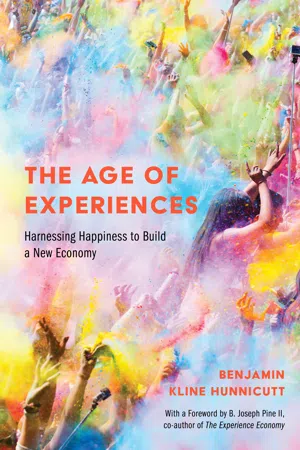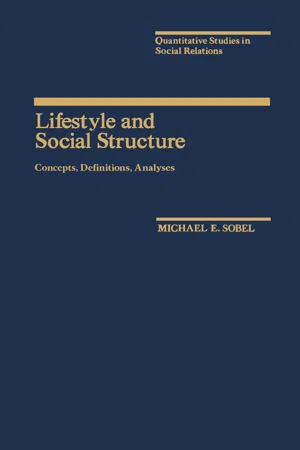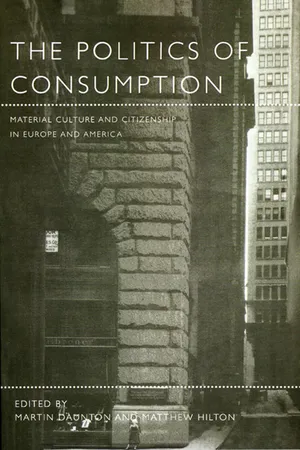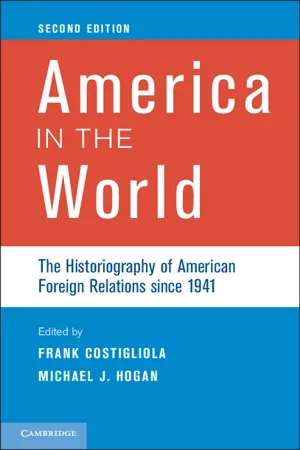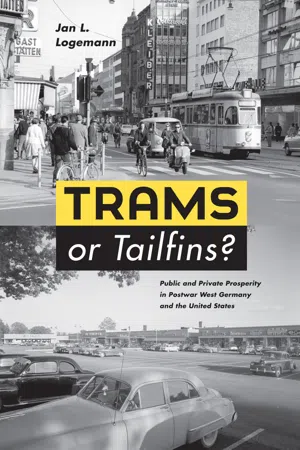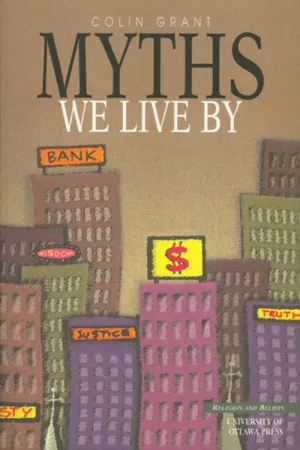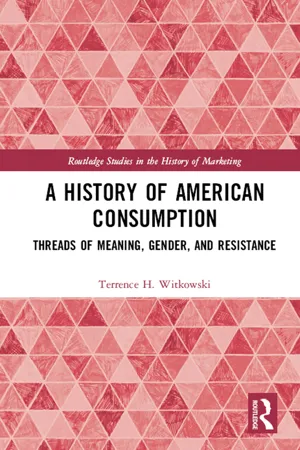History
American Consumerism
American consumerism refers to the culture of excessive purchasing and consumption that emerged in the United States, particularly after World War II. It is characterized by a focus on material possessions, mass production, and advertising. American consumerism has had a significant impact on the economy, society, and environment, shaping the way people live and interact with products and services.
Written by Perlego with AI-assistance
Related key terms
1 of 5
9 Key excerpts on "American Consumerism"
- eBook - PDF
Globalization and Security
An Encyclopedia [2 volumes]
- G. Honor Fagan, Ronaldo Munck, G. Honor Fagan, Ronaldo Munck(Authors)
- 2009(Publication Date)
- Praeger(Publisher)
2 Consumerism Daniel M. Harrison Consumerism can be defined as the institutionalization of social action associated with the human consumption of goods. Consumption is key to all life. For example, plants consume sunlight, water, and nutrients from the earth; animals consume plants and other animals; and most humans consume, at minimum, all of the above. Without consumption, life would cease to exist. Despite consumption’s centrality to all existence, however, the particulars of human consumption are often left unana- lyzed, are overlooked, or are discussed only in superficial ways. To some individu- als, reflecting and analyzing our patterns of buying and selling and examining the consequences of such transactions might appear a bit silly—we might as well sit and think about the air we breathe or the water we bathe in. Consumerism is so ubiqui- tous that we hardly notice just how peculiar it has become. This chapter subjects our ways of individual and collective consumption to investigation and analysis. Although people have been buying and selling commodities (i.e., products sold for money) in ways we would recognize since at least since the Renaissance, what social scientists consider to be contemporary consumer society has been in exis- tence for only about a century (Robbins 2002; Strasser, McGovern, and Judt 1998). It must be one of the great ironies of history that the grey, dour, and miserly Prot- estant work ethic (Weber 1958) would eventually give way to the unbridled, hedo- nistic, consumer-based capitalism that envelops much of the globe today. Many changes in consumer society were initiated during the twentieth century, espe- cially after World War II. During that time, new products and technologies made old ones obsolete . . . Wholly new classes of human activity joined the realm of commodities. Businesses commodified forms of folk culture such as dancing and popular song. - eBook - PDF
The Age of Experiences
Harnessing Happiness to Build a New Economy
- Benjamin Hunnicutt(Author)
- 2020(Publication Date)
- Temple University Press(Publisher)
More recently, however, scholars and researchers in consumer culture theory, siding with traditional promoters, have come to the defense of consumerism, recognizing a growing economy’s positive contributions to individual free-dom, social engagement, and healthy cultural formation. A historical account of this ninety-year debate about consumerism pro-vides a perspective from which one may observe the development of a larger, “novel dialectic” growing from capitalism’s contradictions, including con-sumerism, and the possible emergence of a “new synthesis” made possible by the experience and transformation economies as they begin to more fully realize the positive potential of consumerism revealed by consumer culture theory. 3 Origins of Modern Consumerism and Its Critics: Herbert Hoover and the 1920s The enshrinement of Full-Time, Full Employment in public policy and American politics during Roosevelt’s second term (outlined in Chapter 1) fol-lowed the laying of its cultural foundation during the 1920s. Business’s “new economic gospel of consumption” proclaimed then that the economy could and should grow eternally, founded on a new, “optional consumption”—on the promise that people would continue to work for and buy things they CONSUMERISM AND ITS CRITICS / 65 had never seen before, in perpetuity. 4 The new “gospel” was met by a chorus of doubters who inaugurated a critique of consumerism that has been re-peated, with changes rung on its major themes, since then, the latest iteration being complaints about the coming of the experience and transformation economies. - eBook - PDF
Lifestyle and Social Structure
Concepts, Definitions, Analyses
- Michael E. Sobel, Peter H. Rossi(Authors)
- 2013(Publication Date)
- Academic Press(Publisher)
Nor are the relevant behav-iors always clear, as during periods of major transition. Since the setting for this study is contemporary America, those phe-nomena that are of primary importance in the American experience are discussed. To facilitate the discussion and to demarcate rough timepoints for which the subsequent observations hold, a historical argument is re-quired. Contemporary American life is best understood by understanding American history, that is, by understanding the sequences of ongoing events that combined over a period of time to produce a contemporary social reality distinctly different from that which existed a mere 30 years ago. Following the historical sketch, that demonstrates the salience of consumption in American life, three issues are addressed. First, the rela-tionship between consumption and expressiveness, second, the relation-ship between work and expressiveness, and finally, the relationship be-tween consumption and leisure are considered. The argument that I make leads to a simple conclusion: Americans are a society of consumers. Consumption is an expressive activity that includes much of and shapes the totality of American life in a very pro-found manner. It is not just that Americans live in a society in which activities are increasingly consumed at a cost. Beyond this, it is the fact that Americans attach so much intrinsic importance to this activity that allows the conclusion that lifestyles are created predominantly through consumption. The Historical Argument 1 Between 1860 and 1900 many of the patterns shaping twentieth-century life first emerged in discernible form. On the eve of the Civil War, 1 The validity of the historical argument rests upon the assumption that much of con-sumption reflects induced, as opposed to intrinsic, demand. The consumption mentality could be generated in some other fashion, so that the conclusion of the argument might be correct, independently of the structure of the argument. - eBook - PDF
The Politics of Consumption
Material Culture and Citizenship in Europe and America
- Martin Daunton, Matthew Hilton(Authors)
- 2001(Publication Date)
- Berg Publishers(Publisher)
What we are just beginning to understand, however, is that mass consumption deeply shaped the most central dimensions of life in the twentieth century, and the American political economy and political culture. Although people’s identities as ‘citizens’ and ‘consumers’ are often presented as opposites, the former implying an embrace of the larger public interest in the political sphere and the latter concerned with indulging individual wants in the economic sphere, it is becoming clear that no such simple distinction held true over the course of that century. Rather than isolated ideal types, citizen and consumer were ever-shifting categories that sometimes overlapped, other times were in tension, but always reflected the permeability of the political and economic arenas in twentieth-century America. In this chapter I shall attempt to sketch out an emerging map of the way American citizens and consumers together redrew the boundaries of public life during that period in US history. 204 Lizabeth Cohen I shall focus on three watershed periods when, I argue, the connection between citizen and consumer became restructured and hence the place of consumers in American political culture reconceived. Those three eras include the Progressive Era of the late nineteenth and early twentieth century, the New Deal from the early 1930s through the Second World War, and the post-Second World War period. Although these eras are standard chapters in any history of the twentieth century, rarely if ever are they considered as stages in the evolution of a consumerist vision of citizenship and the state. 1 The consumer burst on the American political landscape as a social category with the rise of Progressivism, and from the 1890s to 1920 most of the ways that consumers would later figure into mainstream political discourse got at least an airing. Progressivism established the centrality of consumers to civic life, even if it failed to secure them a permanent place in public policy. - eBook - ePub
- Daniel Miller(Author)
- 2005(Publication Date)
- Routledge(Publisher)
5 CONSUMPTION WITHIN HISTORICAL STUDIES
Paul Glennie
IThe significance of consumption for history
INTRODUCTION AND BACKGROUND
Earlier this century, industrial and agricultural revolutions were being discovered almost everywhere that historians looked. Recently it has been consumer revolutions, at least among European and American historians (little literature has hitherto addressed other histories of consumption, though see Clunas 1991). Phrases like the birth of consumer society, emergent modern consumption, the rise of mass consumption, and the rise of mass market culture have been applied to the sixteenth and early seventeenth centuries (Thirsk 1978); Restoration England (Earle 1989: Shammas 1990; Weatherill 1988); the early eighteenth century (Eversley 1967); the Georgian period (Campbell 1987; McKendrick, Brewer and Plumb 1982; Williams 1987); the late nineteenth century (Fox and Lears 1983; Fraser 1981; Lee 1981); and between the two World Wars (Miller 1991). And, of course, each account raises questions about defining ‘consumer society’, and about consumption’s connections to wider economic and cultural changes.This proliferation reflects both continuous growth in Western consumption, and historians’ various definitions of ‘consumer society’. In addition, work on consumption is characterised by fragmentation, with very many local case-studies. Most general treatments of consumption either cover short periods and a single country, or take a long-run comparative view only for certain goods. The sheer variety of available sources (artefactual, documentary, visual, literary), and the divergent agendas of specialised research fields in different countries, exacerbate diversity and fragmentation. Different histories inform, and are informed by, highly divergent general analyses on consumption, and many historians distrust explicit theorising as a comparative and synthesising device. - eBook - PDF
America in the World
The Historiography of American Foreign Relations since 1941
- Frank Costigliola, Michael J. Hogan(Authors)
- 2013(Publication Date)
- Cambridge University Press(Publisher)
Indeed, as so much of the rich scholarly literature suggests, politics plays out on the fields of hopes, dreams, and fears that mass consumer sensibilities have conjured. Notes 1 Major recent studies of the global history of consumerism include Peter Stearns, Consumerism in World History: The Global Transformation of Desire, revised ed. (New York: Routledge, 2006); John Brewer and Frank Trentmann (eds.), Consuming Cultures, Global Perspectives: Historical Trajectories, Transnational Exchanges (Oxford: Berg, 2006), quote, pp. 51–52; Frank Trentmann (ed.), The Making of the Consumer: Knowledge, Power and Identity in the Modern World (Oxford: Berg, 2006). Craig Clunas, “Modernity Global and Local: Consumption and the Rise of the West,” American Historical Review 104 (Dec., 1999), 1497–1511 is a review essay; much more bibliography may be found from Trentmann’s Cultures of Consumption project at http://www.consume.bbk.ac.uk/publications. html. Works such as Jeremy Prestholdt, Domesticating the World: African Consumerism and the Geneologies of Globalization (Berkeley: University of California Press, 2008) and Douglas Haynes, Abigail McGowan, Tirthankar Roy, Haruka Yanagisawa (eds.), Towards a History of Consumption in South Emily S. Rosenberg 328 Asia (Delhi: Oxford University Press, 2010) provide an important challenge to seeing consumer globalization as a Eurocentric and twentieth-century phe- nomenon. See Martyn J. Lee (ed.), The Consumer Society Reader (Malden, MA: Blackwell, 2000) for a selection of theoretical works. 2 Brewer and Trentmann (eds.), Consuming Cultures, Global Perspectives. - eBook - ePub
Trams or Tailfins?
Public and Private Prosperity in Postwar West Germany and the United States
- Jan L. Logemann(Author)
- 2012(Publication Date)
- University of Chicago Press(Publisher)
Consumers bought higher-end products in hopes that they would be safer. The strong influence of consumer product testing in West Germany after the introduction of Test in 1966 resulted in an even greater competition over quality in the German market. 125 In the United States, by contrast, “buying at a lower price, or at a discount, [was] more often considered an indication of clever or successful shopping,” as sociologists George Katona and Ernest Zahn observed comparing the two consumer societies as late as 1971. 126 Despite efforts by liberal modernizers in the West German economics ministry to promote an American-style shopping culture, neither German consumers nor many intellectuals abandoned traditional values, at least until after 1970. Who Is the Consuming Public? Between a Democratic Consumer Culture and Inequalities in the Sociology of Consumption Distinct social and cultural contexts explain the two different consumer cultures. In the American case, material consumption became central to achieving middle-class respectability. Built around a trinity of automobile ownership, a suburban home, and the goods that fill the home, American consumers adopted modern, value-driven attitudes toward shopping. Such an outlook certainly dovetailed with the mass production and mass retailing regime that had emerged since the beginning of the twentieth century. Continuously accumulating new goods became a widely shared standard that most consumers could aspire to. This American culture of consumption undeniably had culturally democratic aspects, which were emphasized by the proponents of mass consumption as well as by the populuxe design of many American consumer goods. Bargain prices helped put many goods—albeit at different gradations of quality—within the reach even of lower-income consumer households - eBook - PDF
- Colin Grant(Author)
- 1998(Publication Date)
- University of Ottawa Press(Publisher)
The natural world changes from a sustaining order to a commodity to be owned and exchanged for profit; a person's life is judged by the rate that he or she can command in the labour mar-ket; a person's security in life is determined by the capital that he or she owns as an individual. The intense promotion and acceptance of consumption as a way of life that has characterized our recent past can be seen to be the working out of this commodification of life that began centuries ago. The resulting consumer myth has become so pervasive that we can only look back in pity on those who lacked the abundance of goods that we enjoy. But it may also mean that we are unable to appreciate the rich possibilities that were present before nature became real estate, life became measured by market value, and our security and status were determined by the assets we can claim individually. Consumerism as Materialism If we recognize that our lives are shaped significantly by a consumer myth, we are then faced with the question of what that myth involves. The most obvious feature of consumer culture is its material focus. Many would say that the central difference between our way of life today and that of previous ages is that we are intensely materialistic, and many see this as a fundamental source of concern with consumer culture. It makes things the object of its veneration, and in so doing it reduces persons and the personal to the status of things. This concern is often voiced in the name of religion. Consumer materialism is seen as a prominent foe of Christian concern with the primacy of the per-sonal, in both Catholic and Protestant forms. One Catholic theologian presents his summation of the problem with consumer society in the following terms: We no longer see persons, we see things. And things, like idols, are dead. 11 The Catholic economist E.F. Schumacher subti-tles his influential book Small Is Beautiful with the descriptive phrase - eBook - ePub
A History of American Consumption
Threads of Meaning, Gender, and Resistance
- Terrence Witkowski, Terrence H. Witkowski(Authors)
- 2017(Publication Date)
- Routledge(Publisher)
A photograph in Chapter 1 illuminating material culture methods of inquiry and three in Chapter 4 illustrating the meaning of patriotic symbols, heroes, and national pride in the early nineteenth century are of antiques and art from our family collection (okay, mostly my obsession). Including them allows me to share with readers some of my personal collecting enthusiasms that stimulate my scholarly work. While writing this book I could not resist purchasing some Depression-era ephemera on eBay that will appear in Chapter 7. (I only spent $43.89 with shipping and so got off cheaply this time.) The brief concluding chapter will revisit this history in terms of continuities and change, additional threads deserving of further research, and some lessons for consumer culture theory. Summary The history of American consumption presented in this book is positioned within the research tradition of consumer culture theory. CCT is not a unified theory or over-arching model. It is a diverse school of research interests concerned less with the psychology of consumer decision-making and individual buyer behavior than with the cultural dimensions of consumption including symbolism, ideology, aesthetics, rituals, identity projects, and marketplace customs. The number of CCT studies burgeoned after the mid-1980s although a few earlier examples can be found as far back as the 1930s. The CCT literature largely emerged from the field of consumer research as it had developed within marketing departments in business schools. Marketing academics had acknowledged the importance of studying consumer behavior as early as the 1920s, but serious interest did not commence until about the 1950s when cognitive psychology became popular. Consumer research also has lineages within the field of home economics and through social surveys on living standards that go back to the late nineteenth century
Index pages curate the most relevant extracts from our library of academic textbooks. They’ve been created using an in-house natural language model (NLM), each adding context and meaning to key research topics.

